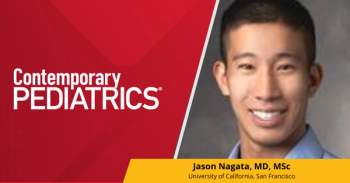
Topical steroid and non-steroidal treatments for pediatric atopic dermatitis and potential new agents
Lawrence Eichenfield, MD, discusses topical steroid, non-steroidal, and potentially new atopic dermatitis treatments for the pediatric population.
In this Contemporary Pediatrics interview, Lawrence Eichenfield, MD, breaks down topical steroid and non-steroidal atopic dermatitis (AD) treatments for the pediatric population.
In addition, Eichenfield highlights anticipated new pediatric AD treatment agents that have the potential to be FDA approved in the future.
This interview with Lawrence Eichenfield is the last of a 3-part discussion of pediatric AD.
Interview transcript (edited for clarity):
Lawrence Eichenfield, MD:
The topical steroids range from super weak to super potent, the numbers don't correlate, right? 2.5%, hydrocortisone is 2.5%. It's a pretty big number in the scheme of things, but it's a low potency topical steroid, very safe to use, but not continuously, because it can thin skin, very little chance of having so much absorption, that you're going to have adrenal problems with that product.
But it's tricky to patients, because if I give them a topical steroid, like 0.1% triamcinolone, which is the standard, is 0.1%, it's a lower number and our most potent topical steroid, the one that's 2000 times stronger, is point .05% clobetasol. So that's confusing. It's not intuitive, the numbers don't necessarily correlate and there can be concerns with topical steroids, if they're used in a continuous manner, or just the quantity of use is too much. So I mean, our new model is to really sort of get a sense of what quantity patients are using, and to direct them to what quantity they might use.
They should also know, a pediatrician should also know, that there's this increasing number of non-steroidal topical agents with really new technologies that will be helpful. We had calcineurin inhibitors, you know, in 2000 and 2001, they're tried and true to a degree, not that much use amongst general pediatricians. There were concerns that were raised about potential cancer back in the early 2000, even though the data's come back negative for that. They have restricted age of of use, still reliable products. We had topical crisaborole approved a few years ago, it can work quite well.
In some individuals there can be some stinging and burning with that, but it can be highly useful, and that's approved down to 3 months of age, and recently got approved in a daily use where they used it every day for a year, you could never do that with a topical steroid. And then we have these new agents. So topical ruxolitinib is a topical JAK inhibitor that's approved already ages 12 years and older that have some early data.
Then we have two totally new different types of products. One is topical tapinarof, which is an aryl hydrocarbon receptor agonist, and my pediatrician should go, "what, I've never heard of that," because we haven't heard of that. This is a whole different mechanism of action. It's not a steroid, already approved for psoriasis in adults. They've completed their pediatric studies with that 1% cream down to children age 2 with really really good datasets and can be very, very exciting and that drug's become very popular for psoriasis in adults.
Then roflumilast has completed their clinical trials at different formulations for atopic dermatitis, that's a novel PDE4 inhibitor. So we've seen a topical PDE4 with crisaborole, but this is a novel agent. So those aren't ready to be handed to the patient yet, or to my pediatric colleagues to hand to their patients. But, hopefully we'll move along in the process of approval. The takeaway is that we want to bring long term disease control, regardless of severity for atopic dermatitis patients.
We'd like to do it efficiently and safely. There's a burden of care for the patients, a bit of a burden of care for our pediatric colleagues to educate families how to use it appropriately, but an increasing set of tools that allow you to do that much more effectively.
Eichenfield disclosed the following with Contemporary Pediatrics:
Board membership, Verrica Pharmaceuticals
Grants/research funding pending, Amgen, Johnson & Johnson
Stock ownership, Verrica, Forte (options for both)
Consultant/Advisor, Arcutis
Board, Arcutis
Investigator/Research grant, Arcutis
Eichenfield has served as a consultant, speaker, advisory board member or investigator for AbbVie, Amgen, Arcutis, Aslan, Bristol-Myers Squibb, Castle Biosciences, Dermavant, Eli Lilly, Forte, Galderma, Incyte, Janssen, Johnson & Johnson, LEO Pharma, Novartis, Ortho Dermatologics, Pfizer, Regeneron, Sanofi-Genzyme, Target RWE and UCB.
Newsletter
Access practical, evidence-based guidance to support better care for our youngest patients. Join our email list for the latest clinical updates.

![Jodi Gilman, PhD, on cumulative prenatal adversity linked to adolescent mental health risk Document Jodi Gilman, PhD, on cumulative prenatal adversity linked to adolescent mental health risk Live? Do you want this document to be visible online? Scheduled Publishing Exclude From Home Page Do you want this document to be excluded from home page? Exclude From Infinite Scroll Do you want this document to be excluded from infinite scroll? Disable Related Content Remove related content from bottom of article. Password Protection? Do you want this gate this document? (If so, switch this on, set 'Live?' status on and specify password below.) Hide Comments [Experiment] Comments are visible by default. To hide them for this article toggle this switch to the on position. Show Social Share Buttons? Do you want this document to have the social share icons? Healthcare Professional Check Is Gated [DEV Only]Do you want to require login to view this? Password Password required to pass the gating above. Title Jodi Gilman, PhD, on cumulative prenatal adversity linked to adolescent mental health risk URL Unique identifier for this document. (Do not change after publishing) jodi-gilman-phd-on-cumulative-prenatal-adversity-linked-to-adolescent-mental-health-risk Canonical URL Canonical URL for this document. Publish Date Documents are usually sorted DESC using this field. NOTE: latency may cause article to publish a few minutes ahead of prepared time 2026-01-19 11:52 Updated On Add an updated date if the article has been updated after the initial publish date. e.g. 2026-01-19 11:50 Article Type News Display Label Author Jodi Gilman, Phd > Gilman, Jodi Author Fact Check Assign authors who fact checked the article. Morgan Ebert, Managing Editor > Ebert, Morgan Content Category Articles Content Placement News > Mental, Behavioral and Development Health > Clinical AD Targeting Group Put the value only when the document group is sold and require targeting enforcement. Type to search Document Group Mapping Now you can assign multiple document group to an article. No items Content Group Assign a content group to this document for ad targeting. Type to search Issue Association Please choose an issue to associate this document Type to search Issue Section Please choose a section/department head if it exists Type to search Filter Please choose a filter if required Type to search Page Number Keywords (SEO) Enter tag and press ENTER… Display summary on top of article? Do you want display summary on top of article? Summary Description for Google and other search engines; AI generated summary currently not supporting videos. Cumulative prenatal adversities were linked to higher adolescent mental health risk, highlighting the importance of prenatal history and early clinical monitoring. Abstract Body *********************************************************************************************************** Please include at least one image/figure in the article body for SEO and compliance purposes ***********************************************************************************************************](https://cdn.sanity.io/images/0vv8moc6/contpeds/e6097cb5e6d6c028c0d4e9efd069e69fdab6d00b-1200x628.png?w=350&fit=crop&auto=format)






